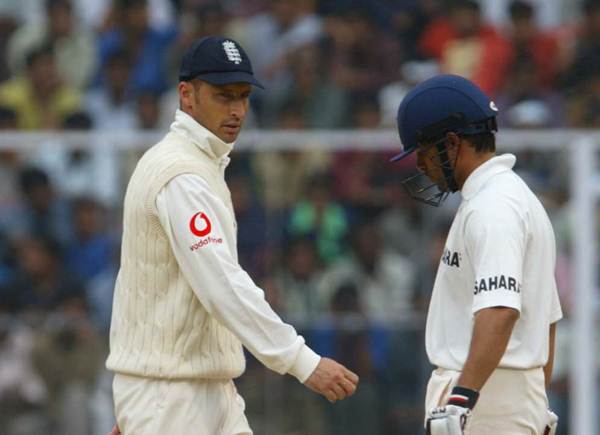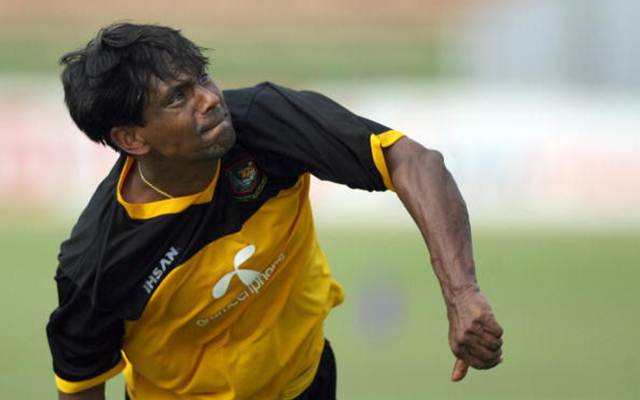5 Weirdest stats in cricket history
Here we look at five weirdest stats which have been recorded till date in cricket:
2 Min Read


Vernon Philander. (Photo Source: Twitter)

Cricket has been blessed to have a variety of stats be it in the batting, bowling or fielding department irrespective of the format. Some of the stats and fact of this sport which officially began in 1772 does surprise the crazy fanatics of the game. One of the many strange facts of cricket is that the biggest ODI successful chase of 435 by South Africa is higher than West Indies’ 418-run chase which is the largest successful chase in Test cricket.
Here we look at five weirdest stats which have been recorded till date in cricket:
(Note: All the stats mentioned in the article are of Men’s cricket only)
5. Consecutive toss losses

Nasser Hussain had some forgettable moments at the toss which didn’t stop him from leading England to famous wins. He became regular captain of England post the 1999 World Cup and a year later, he spent more than 12 successive months without winning the toss coin even once.
Nasser captained England during 14 matches in International Cricket between the last week of November 2000 and the first week of December 2001. He failed to win even one toss during that period at this level.
Ten of the 14 consecutive tosses came in Test cricket while the other four during the ODI series hosted by Zimbabwe. Those ten Test matches were part of 4 Test series – in Pakistan, in Sri Lanka, in India and home Ashes. The fascinating fact from Nasser’s successive toss losses is the 10 consecutive toss losses in Test cricket is equivalent to 1/1024 in probability while the probability of 14 consecutive toss losses in International cricket is a one in a 16384 occurrence.
4. Bowling more than 10 overs in a 50-over match

Mohammad Rafique was a legendary figure in Bangladesh cricket as the all-round amassed 1000+ runs in both ODIs and Test cricket alongside picking up 100+ wickets in both the formats. The left-hander featured in 33 Test matches, 125 ODIs and one T20I match through his 13-year International career. Rafique created various records for Bangladesh but the strangest one remains him bowling more than 10 overs in a 50-over ODI match. 12 overs are the most bowled in an ODI but during the 60-over games.
No ODI played since 1996 has been more than of 50 overs but the left-arm spinner bowled 10.2 overs during an ODI game in 2004. Even till 1995, only England used to host ODIs of more than 50 overs. Seven ODIs hosted by Australia and New Zealand during the 1970s were 40-over matches where an over consisted 8 balls. A maximum of 8 overs were bowled in those 7 ODIs i.e. 64 balls of the 320 deliveries in the innings. Mohammad Rafique bowled 10.2 overs during the 2004 Asia Cup match against Hong Kong.
Rafique completed his quota of 10 overs by 44th over of the chase with the figures of 10-3-19-1. He bowled the 46th over as well by virtue of miscalculation by the officials. Khalid Khan took a couple on the 1st ball before being dismissed on the next as Hong Kong were bowled out for 105 in reply to Bangladesh’s 221/9. The 116-run victory was Bangladesh’s maiden win in Asia Cup after they lost each of their first 16 matches played across 6 editions of Asia Cup.
3. Batting through completed team’s innings twice in a match

Opening the innings and batting till the fall of team’s last wicket is something not many players have achieved in their careers. Even more unusual instance is a player batting through team’s innings twice in a match. No such occurrences have been registered in Test cricket till date but 10 players achieved this rare feat at least once in first-class cricket. Among those ten, only one player has achieved this strange record not once but on two different instances – Henry Jupp of Surrey, an English county team.
Henry batted through team’s innings twice in two first-class matches; both of them before 19th century and was the first to do so as well. The right-handed batsman’s first instance came during 1866 County match against Hampshire. Surrey were bowled out for only 110 in their first innings. Jupp stood through Surrey’s innings of 56.3 overs before getting runout for 31 runs as the last wicket. Surrey were enforced to follow as Hampshire made 208 batting 1st. Jupp led Surrey to make a comeback as the hosts made 297 in their 2nd innings.
The opening batsman scored an unbeaten 94 and carried the bat through the innings. Hampshire were bowled out for only 140 in the replay and lost the game by 59 runs. Henry Jupp’s second instance came during the 1874 County Championship against Yorkshire.
Henry carried the bat in both innings respectively where he scored 43* and 109*. Surrey were rolled out for only 95 in their first innings and made to follow-on. The total of 193 in the 2nd essay wasn’t enough for Surrey as the Yorkshire team chased down the target of 102 by losing six wickets.
2. Playing four innings on the same day in Test cricket

Not often both the teams in a Test get a chance to bat in two innings on the same day. But this unusual instance has been witnessed in 3 different Tests. Even more fascinating thing is all the three occasions have been recorded since 2000. The first of them was recorded during the 2000 Lord’s Test between England and West Indies. The opening day was interrupted due to bad light after West Indies scored 267/9 in 89.2 overs. Courtney Walsh was dismissed on the very first ball of the 2nd day bringing an end to West Indies innings.
England were bowled out for 134 in 48.2 overs during their first innings but bounced back strongly by restricting the visitors to mere 54 runs in the 2nd essay that lasted only 26.4 overs. England began their chase of 188 on the same day as they went to stumps at 0/0 in 1.1 overs. The day ended with Walsh bowling his first ball of the innings making him the first player to bat and bowl twice in the same day’s play of a Test match.
The recent such occurrence was recorded during the 2011 Cape Town Test between the Saffers and Australia. The 2nd day of the match began with Michael Clarke (107*) and Peter Siddle (0*) batting for Australia who scored 214/8 on day 1. They were eventually bowled out 284 and restricted the hosts to just 96 in an innings which lasted only 24.3 overs. South Africa came back strongly at the Aussies to bowl them out for just 47 and limited the lead to 236 runs.
Proteas finished the day on 81/1 in 17 overs which was the 4th innings of the day. Only Peter Siddle batted twice and bowled twice through the day’s play. The other instance of four innings in single day of a Test match was recorded in the 2002 Hamilton Test between New Zealand and India. The visitors ended the 2nd day on 92/8 after the whole first day was washed out. But they lasted only seven balls on the 3rd day morning where they added 7 runs to overnight score.
The hosts didn’t last long as they were bundled out for only 94 and conceded a 5-run lead. India batted much better in the 2nd essay but could only manage 154 on a tricky track. The Kiwis got to play 15 overs before the stumps on day 3 where they scored 24/0. India’s last pair in both innings, Ashish Nehra and Tinu Yohannan got a chance to bat twice and bowl twice on the 3rd day. Nehra was dismissed in both innings while Yohannan remained unbeaten twice. Thus, Nehra holds the unique distinction of being dismissed twice and bowling in two innings on the same day.
1. Hashim Amla and milestone dismissals

The milestones wickets are witnessed once in a while and have a greater probability of involving different players at every occasion. However, Hashim Amla was part of milestone wickets in Test cricket not once or twice but on as many as three occasions. Amla became the 60000th wicket of Test cricket when he was dismissed by Shane Shillingford during the Basseterre Test during their tour of West Indies in 2010. He scored 44 in the first innings before edging one to the slip fielder Dwayne Bravo.
Six years down the line, Amla was part of yet another milestone wicket in this format. The South African was trapped in front for 48 by Nuwan Pradeep during the 2nd innings of the Port Elizabeth Test against Sri Lanka which began on Boxing Day. Amla’s wicket turned out to be the 10000th dismissal in Test cricket of Leg before Wicket (LBW). Hashim’s connection with milestone wickets continued in 2017 when Bangladesh toured South Africa for a 2-match Test series.
He was dismissed by Shafiul Islam after scoring 137 in the 2007 Potchefstroom Test as Amla cut one straight to Mehidy Hasan Miraz at backward point. This wicket of Hashim Amla turned out to be the 70000th wicket to have fell in Test cricket. If not for the DRS system, Amla wouldn’t been the 70000th wicket of Test cricket. Dilruwan Perera, who was playing against Pakistan at the same time, was given out little before Amla’s wicket but the Sri Lankan all-rounder made a successful review.
Download Our App